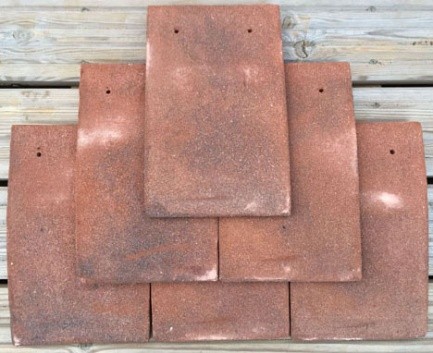Handmade Roof Tiles in Bedfordshire
Heritage Tiles: Emblematic of the finest craftsmanship
Heritage tiles are the professional roofer's choice for the highest quality clay roof tiles. We pride ourselves in manufacturing, stocking, and delivering the very finest in prestige clay roof tiles.
Heritage Tiles have several tile ranges that satisfy every architectural requirement. Vintage and historic properties right up to modern new builds are covered by the diverse range of clay roof tiles that we stock.
So, whether you are in the building trade, or simply wish to choose your own tiles, Heritage Tiles have the right product for your specific requirements.
What Heritage Tiles have to offer our customers?
- We offer specification and technical solutions to help you achieve the perfect build.
- We also offer expert design advice to all our customers.
- We are happy to engage in site visits with our clients.
- We have stockists and distributors throughout the United Kingdom to ensure that we can provide our expert service to a wider area.
- We can provide estimated quantities from plans supplied by our clients.
- We offer battening plans.
- We can deliver a standard and bespoke colour choice for our clay tile products.
- All our tiles are assessed and approved by Lucideon.
- We provide a nationwide delivery and collection service.
The ranges of clay roof tiles we supply.
The Clayhall Range of roof tiles:

Clayhall Medium Blend - Carefully crafted to replicate all the features of handmade the Clayhall hand crafted range of tiles offers an excellent alternative when budget restrictions are a concern, but without compromising quality or durability.
Clayhall Dark Blend - Quality and durability in a budget clay roof tile. The Clayhall dark blend is sure to turn heads.
Clayhall Red Blend - A beautiful rustic clay roof tile. The Clayhall red blend is a firm favourite with our customers.
Clayhall Hamlet Mix - The Clayhall Hamlet mix is a gorgeous light and sandy looking clay roof tile that is a perennial favourite in the building trade.
Clayhall Birchwood Mix - The Clayhall Birchwood mix offers a gorgeous blend of lighter and darker shades in this diverse clay roof tile. If you are concerned that your roof tiles could look monotonous, the Clayhall Birchwood mix is the clay roof tile to choose.
The Conservation Range of roof tiles

The Conservation range of roof tiles are available in a range of distinctive colours, created by using a very fine sand, The Conservation Weathered; A natural warm tone, achieving an instant mellow and settled look and The Conservation Red; perfect for vertical tiling especially suited for villages and hamlets with olde world vernacular charm.
Manufactured using high quality clay, achieving high strength and durability properties, giving homeowners and contractors peace of mind for many years to come. The conservation range comes with a complete set of associated fittings, including Hog Back Ridge, Half Round Ridge, Bonnet Hips, Valley tiles and External Angles.
The Conservation range of clay roof tiles comes in the following variations:
- Conservation Red
- Conservation Weathered
- Conservation Dark
Conservation Peg Tile
Plain clay roofing tiles laid to a double lap have been used for roof covering in England since before the Norman Conquest and tiles dating back to Roman Times have been discovered under excavation. From the outset clay plain tiles were made incorporating fixing features.
The Classic Edwardian roof tile
The Classic range of plain tiles is one of the finest ranges of clay tiles.
We source only the best raw materials for our craftsman to create beautifully handmade clay tiles of the highest quality and durability.
Tile Fittings available from Heritage Tiles
There are many fittings that are available from us a Heritage Tiles to complete your build to perfection. We stock and supply the following:
- Gable Tile
- Eave Tile
- Baby Porch Ridge
- 90 Degree Ext. Angle
- Universal Bonnet Hip
- Half Round Ridge
- Hogs Back Ridge
- Mono Ridge
- Third Round Ridge
- Universal Valley
- Ornamental Club
- Bat Tile Set
Bat Tiles:
Provide help for our bats with our range of bat friendly roof tiles.
Did you know that all UK bats and their roosts are protected by law? The Wildlife and Countryside Act introduced in 1981, gave legal protection to all bat species and their roosts in England.
Distinct species of bats prefer differing places to roost. The two most usually found species of bat in the UK are the Pipistrelle and Brown Long-Eared Bat. Pipistrelle prefer confined spaces such as under tiles on roofs and hanging spaces. The Brown Long-Eared Bat prefer roof timbers and ridges inside lofts. Heritage Clay Tiles can provide purpose made access points within your roof tiles or ridge tiles. The Bat Tile Set can form part of a mitigation package required by law for existing roosts or as potential access where a roost had not previously been present.
Select a Blend
Getting the right blend for your roofing project can feel daunting, but with our blend generator you can mix and match various blends of tiles to achieve the perfect blend.
Click here to make use of our online tool to choose your own unique blend.
Because our strict quality control provides a consistent tile size you can mix assorted styles and colours of tiles to make your roof unique to you. Please use the tool below to experiment with various blends.
Adjust the sliders to set the ingredients for your desired blend then click on the update mix button.
Alternatively click on any blend or tile to display it.
Whatever type of clay roof tile you want, Heritage Tiles will be able to help.
Handmade Roof Tiles
The manufacture of handmade roof tiles
You may be surprised to learn that the clay used for making handmade roof tiles isn't processed as soon as it comes from the ground. Following the clay being excavated from the earth, it has to be weathered for around nine months to a year.
The clay is then ground into very fine particles with water added to make the clay workable. Even more surprisingly, a substance which is previously fired clay pieces that have been ground down is added to the fresh clay to help reduce the shrinking, cracking and warping that can happen during the firing process. This addition of pre-fired particles also adds to the texture of the handmade roof tile.
In the past, handmade roof tiles would have been hand thrown into the mould before being finished. Owing to time constraints in production, nowadays they are often mechanically pressed either by hand or by using a hydraulic press to ensure a more consistent density and to speed up production. The consistency that is desired extends to the shape of the handmade roof tile too. After all, without this consistency of shape, the builder would have a much harder job fitting handmade roof tiles to the building project. You want to achieve a handmade look to the roof tile, but they still need to marry up to prevent water and other weather ingress.
The handmade roof tiles are then handled and dried in several ways to create the different character variations of shape and colour. The shape is created either by hand or machine and the colour can be varied by adding different oxides or pigments.
Temperature variations within the firing kiln will also lead to variations in tile colour, with a higher temperature resulting in a darker handmade roof tile.
What to look for in handmade roof tiles
It is recommended that handmade roof tiles have been mixed from at least three different crates that are not part of the same manufacturing run, to allow for the desired variations within batches. Laying a roof using handmade roof tiles picked from sequential crates is likely to result in pronounced stripes or blocks of colour on the finished roof and this will detract from the natural look, or blend that you want to achieve.
Handmade roof tiles to withstand the English winter
The density of any handmade roof tile is vital as the denser the tile, the less water it is going to absorb, which means the tile, is less susceptible to frost damage. Frost damage can cause handmade roof tiles, or any other clay product to crack. It's important to check that your handmade roof tiles have been tested for frost resistance as a poor-quality handmade roof tile could lead to very expensive repairs or possibly a complete re-roof.
A handmade roof tile can cost up to 50% more than a machine-made, or stock clay roof tile, but they offer a far more pleasing shape, texture and colour variation. The real benefit of a handmade roof tile tends to centre on the aesthetic appeal and for period properties; this is what you will be looking for. A period property with an entire roof made from machine made, dimensionally perfect roof tiles just looks wrong. Handmade roof tiles simply enhance any period property, which is why they are so sought after.
So, if you have a building project and you feel that it would benefit from the aesthetic superiority of a handmade roof tile, why not drop us a line and discuss your options?
A little information about Bedfordshire
Wrest Park in Bedfordshire
Wrest Park is a picturesque country estate located in Silsoe, Bedfordshire. It comprises Wrest Park, a Grade I listed country house, and Wrest Park Gardens, also Grade I listed, formal gardens surrounding the mansion.
History of the Bedfordshire country estate
The celebrated poet Thomas Carew, who lived from 1595 to 1640, wrote his country house poem "To My Friend G.N. from Wrest" in 1639 that described the old Bedfordshire house which was demolished between 1834 and 1840.
The present house was built in 1834-39, to designs by its owner Thomas de Grey, 2nd Earl de Grey, an amateur architect and the first president of the Royal Institute of British Architects, who was inspired by buildings he had seen on trips to Paris. He based his Bedfordshire property on designs published in French architectural books such as Jacques-Francois Blondel's Architecture Francaise. The works were superintended as clerk of works on site by James Clephan, who had been clerk of the works at the Liddell seat, Ravensworth Castle in County Durham, and had recently served as professional amanuensis and builder for Lord Barrington.
Although Nikolaus Pevsner previously stated that Clephan was a French architect who designed the present house instead of De Grey the amateur architect, as Charles Read has shown in his biography of De Grey, Clephan in fact only produced drawings of the service infrastructure, such as plumbing and drainage. The decorative layout and features of the Bedfordshire house we see today were produced by De Grey himself.
The Bedfordshire property has some of the earliest Rococo Revival interiors in England. The reception rooms in the house are open to the public and are viewed as a major tourist attraction within Bedfordshire.
Like many stately homes and larger properties, the Bedfordshire house was operated as a military hospital during World War I, though a fire in September 1916 put an end this use of the house. The estate was sold after the War to Mr JG Murray, who was associated with cricket in Bedfordshire. During his 18-year tenure, much of the garden statuary was sold, while extensive felling stripped park and garden of many of their oldest trees.
A slice of Bedfordshire that is well worth a visit
The Bedfordshire Park is divided by a wide gravel central walk, continued as a long canal that leads to a Baroque pavilion banqueting house that was completed in 1711. The interior of the pavilion is decorated with an impressive Ionic columns in trompe-l'oeil. Boundary canals were altered to take the more natural shape by Capability Brown, who worked in this part of Bedfordshire between 1758 and 1760, and who also ringed the central formal area with a canal and woodland. During the later 18th and 19th centuries, an orangery and marble fountains were added. The Bathhouse was built, and its grounds laid out, between about 1769 and 1772.
In 1736 Horace Walpole visited Wrest on a progress through Northamptonshire and Bedfordshire. He noted monuments in the garden in memory of the Duke of Kent's children who all predeceased him, as well as a monument to Kent himself, who was at that time still alive.
Products available from Heritage Clay Tiles Ltd in East Sussex
Clay Roof Tiles in East Sussex
Clayhall Roof Tiles in East Sussex
Conservation Roof Tiles in East Sussex
Edwardian Roof Tiles in East Sussex
Victorian Roof Tiles in East Sussex
Georgian Roof Tiles in East Sussex
Handmade Clay Tiles in East Sussex
Handmade Roof Tiles in East Sussex
High Quality Roof Tiles in East Sussex
Traditional clay tiles in East Sussex
Traditional roof tiles in East Sussex
Products available from Heritage Clay Tiles Ltd in Essex
Conservation Roof Tiles in Essex
High Quality Roof Tiles in Essex
Traditional clay tiles in Essex
Traditional roof tiles in Essex
Products available from Heritage Clay Tiles Ltd in Hampshire
Clayhall Roof Tiles in Hampshire
Conservation Roof Tiles in Hampshire
Edwardian Roof Tiles in Hampshire
Victorian Roof Tiles in Hampshire
Georgian Roof Tiles in Hampshire
Handmade Clay Tiles in Hampshire
Handmade Roof Tiles in Hampshire
High Quality Roof Tiles in Hampshire
Traditional clay tiles in Hampshire
Traditional roof tiles in Hampshire
Products available from Heritage Clay Tiles Ltd in Hertfordshire
Clay Roof Tiles in Hertfordshire
Clayhall Roof Tiles in Hertfordshire
Conservation Roof Tiles in Hertfordshire
Edwardian Roof Tiles in Hertfordshire
Victorian Roof Tiles in Hertfordshire
Georgian Roof Tiles in Hertfordshire
Handmade Clay Tiles in Hertfordshire
Handmade Roof Tiles in Hertfordshire
High Quality Roof Tiles in Hertfordshire
Traditional clay tiles in Hertfordshire
Traditional roof tiles in Hertfordshire
Products available from Heritage Clay Tiles Ltd in Kent
Conservation Roof Tiles in Kent
High Quality Roof Tiles in Kent
Traditional clay tiles in Kent
Traditional roof tiles in Kent
Products available from Heritage Clay Tiles Ltd in London
Conservation Roof Tiles in London
Edwardian Roof Tiles in London
Victorian Roof Tiles in London
High Quality Roof Tiles in London
Traditional clay tiles in London
Traditional roof tiles in London
Products available from Heritage Clay Tiles Ltd in Surrey
Conservation Roof Tiles in Surrey
Edwardian Roof Tiles in Surrey
Victorian Roof Tiles in Surrey
High Quality Roof Tiles in Surrey
Traditional clay tiles in Surrey
Traditional roof tiles in Surrey
Products available from Heritage Clay Tiles Ltd in West Sussex
Clay Roof Tiles in West Sussex
Clayhall Roof Tiles in West Sussex
Conservation Roof Tiles in West Sussex
Edwardian Roof Tiles in West Sussex
Victorian Roof Tiles in West Sussex
Georgian Roof Tiles in West Sussex
Handmade Clay Tiles in West Sussex
Handmade Roof Tiles in West Sussex
High Quality Roof Tiles in West Sussex
Traditional clay tiles in West Sussex
Traditional roof tiles in West Sussex
Products available from Heritage Clay Tiles Ltd in Bedfordshire
Clay Roof Tiles in Bedfordshire
Clayhall Roof Tiles in Bedfordshire
Conservation Roof Tiles in Bedfordshire
Edwardian Roof Tiles in Bedfordshire
Victorian Roof Tiles in Bedfordshire
Georgian Roof Tiles in Bedfordshire
Handmade Clay Tiles in Bedfordshire
High Quality Roof Tiles in Bedfordshire
Traditional clay tiles in Bedfordshire
Traditional roof tiles in Bedfordshire
Products available from Heritage Clay Tiles Ltd in Berkshire
Clayhall Roof Tiles in Berkshire
Conservation Roof Tiles in Berkshire
Edwardian Roof Tiles in Berkshire
Victorian Roof Tiles in Berkshire
Georgian Roof Tiles in Berkshire
Handmade Clay Tiles in Berkshire
Handmade Roof Tiles in Berkshire
High Quality Roof Tiles in Berkshire
Traditional clay tiles in Berkshire
Traditional roof tiles in Berkshire
Products available from Heritage Clay Tiles Ltd in Buckinghamshire
Clay Roof Tiles in Buckinghamshire
Clayhall Roof Tiles in Buckinghamshire
Conservation Roof Tiles in Buckinghamshire
Edwardian Roof Tiles in Buckinghamshire
Victorian Roof Tiles in Buckinghamshire
Georgian Roof Tiles in Buckinghamshire
Handmade Clay Tiles in Buckinghamshire
Handmade Roof Tiles in Buckinghamshire
High Quality Roof Tiles in Buckinghamshire
Traditional clay tiles in Buckinghamshire
Traditional roof tiles in Buckinghamshire
Products available from Heritage Clay Tiles Ltd in Cambridgeshire
Clay Roof Tiles in Cambridgeshire
Clayhall Roof Tiles in Cambridgeshire
Conservation Roof Tiles in Cambridgeshire
Edwardian Roof Tiles in Cambridgeshire
Victorian Roof Tiles in Cambridgeshire
Georgian Roof Tiles in Cambridgeshire
Handmade Clay Tiles in Cambridgeshire
Handmade Roof Tiles in Cambridgeshire
High Quality Roof Tiles in Cambridgeshire
Traditional clay tiles in Cambridgeshire
Traditional roof tiles in Cambridgeshire
Products available from Heritage Clay Tiles Ltd in Oxfordshire
Clay Roof Tiles in Oxfordshire
Clayhall Roof Tiles in Oxfordshire
Conservation Roof Tiles in Oxfordshire
Edwardian Roof Tiles in Oxfordshire
Victorian Roof Tiles in Oxfordshire
Georgian Roof Tiles in Oxfordshire
Handmade Clay Tiles in Oxfordshire
Handmade Roof Tiles in Oxfordshire
High Quality Roof Tiles in Oxfordshire
Traditional clay tiles in Oxfordshire
Traditional roof tiles in Oxfordshire
Products available from Heritage Clay Tiles Ltd in Suffolk
Clayhall Roof Tiles in Suffolk
Conservation Roof Tiles in Suffolk
Edwardian Roof Tiles in Suffolk
Victorian Roof Tiles in Suffolk
Georgian Roof Tiles in Suffolk
Handmade Clay Tiles in Suffolk
Handmade Roof Tiles in Suffolk
High Quality Roof Tiles in Suffolk
Traditional clay tiles in Suffolk
Traditional roof tiles in Suffolk
Further Information
If you would like to know more or are interested in a quote we would be happy to help. Phone us on 01634 471 344, email us at sales@heritagetiles.co.uk and we will be in touch as soon as possible.







